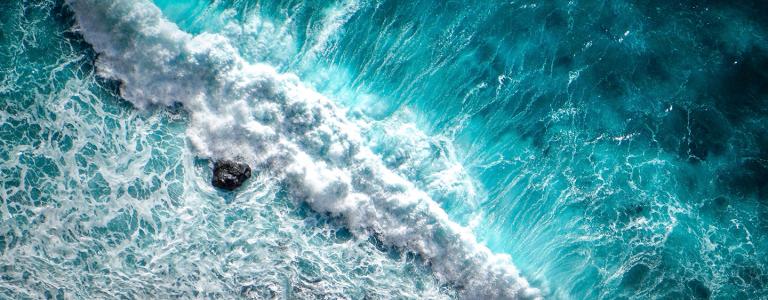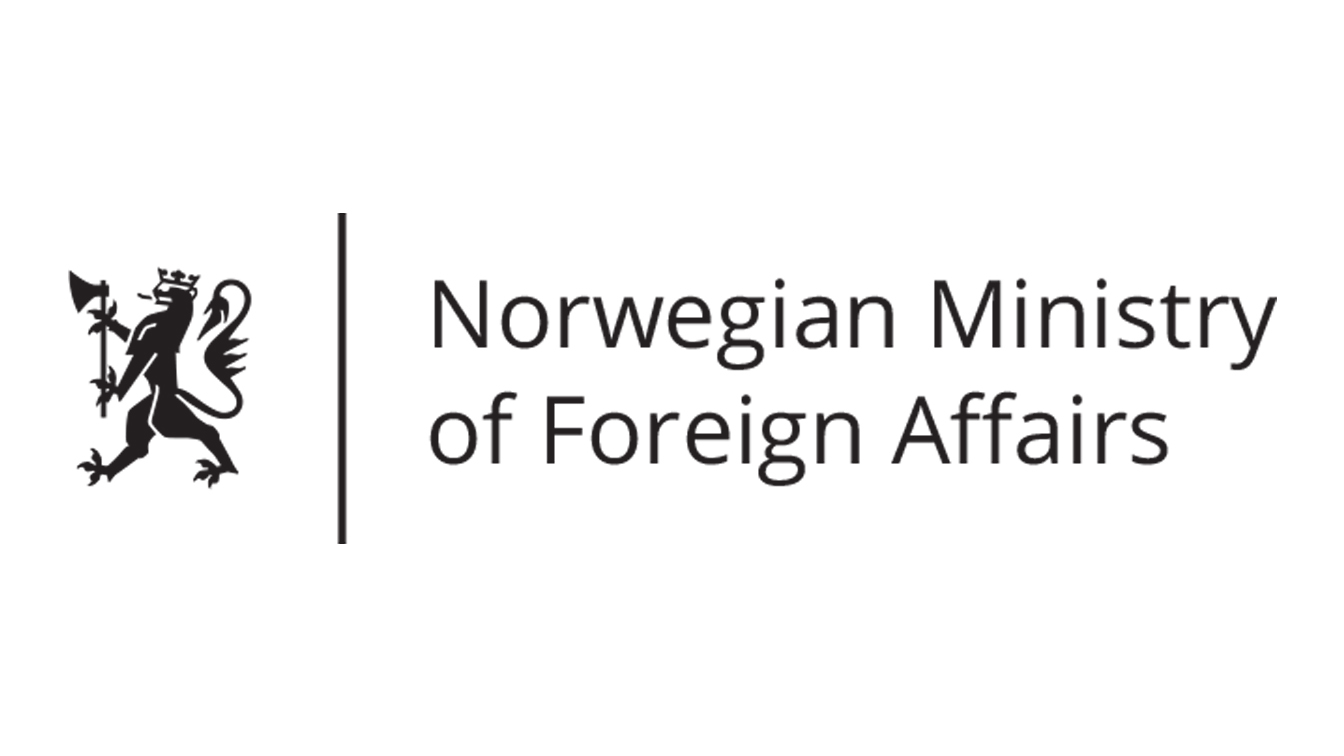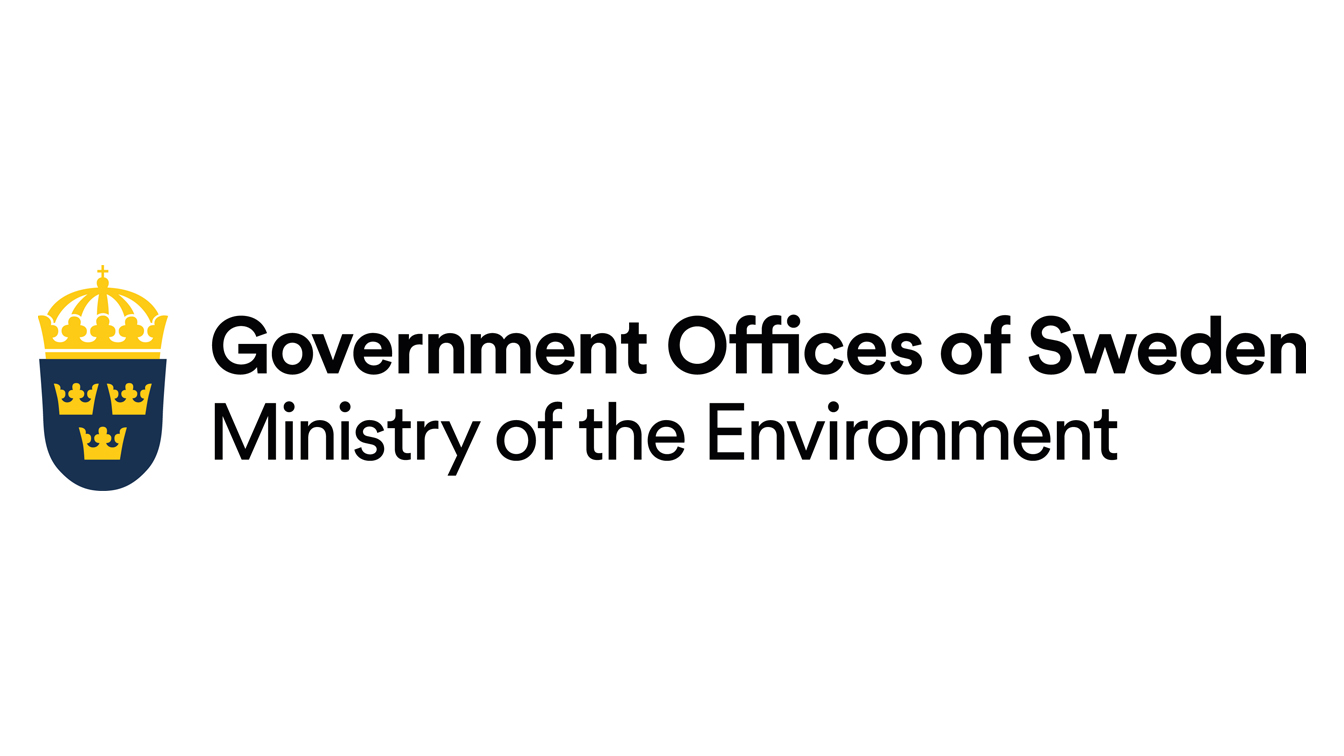The Rising Pressures on Ocean Governance
Still Only One Earth: Lessons from 50 years of UN sustainable development policy
The ocean is under serious threat, with stressors that include overfishing, marine pollution, habitat destruction, and acidification. The rising pressure of these overlapping stressors and the need to consider cumulative impacts require a more holistic approach to ocean governance based on integrated management and the ecosystem approach. (Download PDF) (See all policy briefs) (Subscribe to ENB)
Our home is called the blue planet for a reason. The ocean covers more than 70% of the Earth’s surface. The marine environment is of vital importance for humanity. The ocean generates half of the oxygen we breathe. It contains 97% of the world’s water. It regulates climate and weather patterns. It provides food and sustains livelihoods for over three billion people. It provides the transport route for 90% of global trade.
Scientists estimate more than two million species live in the ocean and we have barely identified 10%. But some of the species we have discovered are proving very useful, including in biomedical research. Human activities have degraded or destroyed the marine ecosystem, jeopardizing the invaluable services it provides. Climate change, marine pollution, overfishing, destruction of marine and coastal habitats, invasive species, oil, and gas extraction—the hazards are extensive. These threats not only rob the ocean of its aesthetic and inspirational value—they directly endanger human survival. There can be no sustainable future without a healthy ocean.
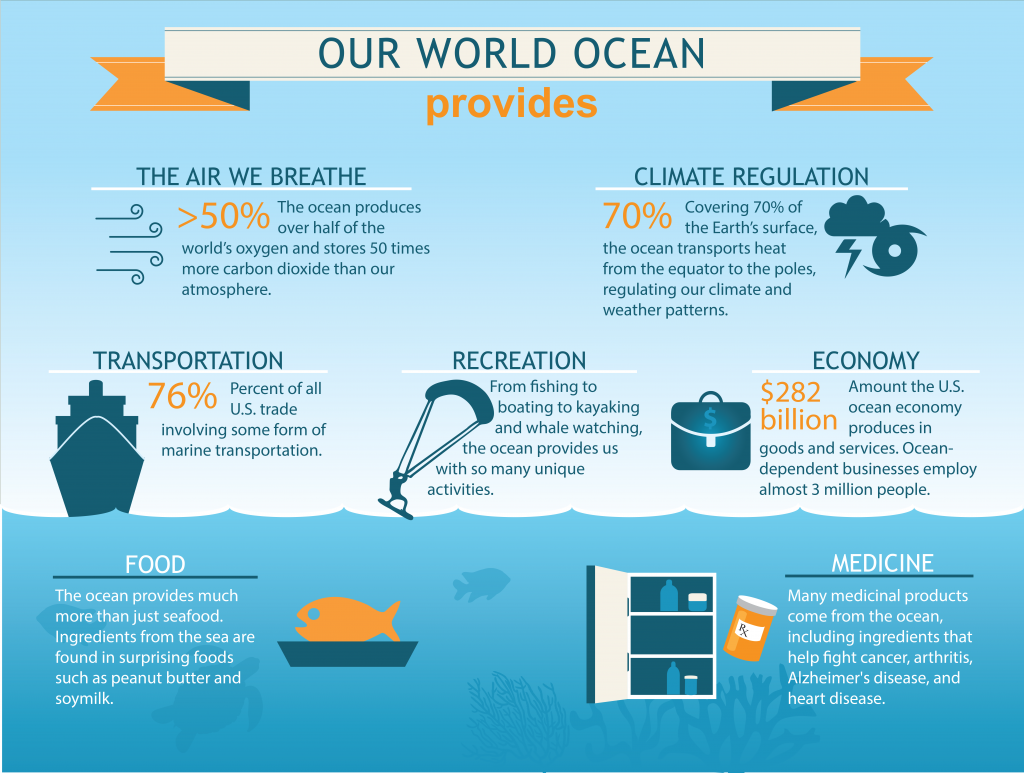
The Birth of Ocean Governance
International ocean governance attempts to manage the ocean and its resources in a way that ensures its health, productivity, and resilience. The complexity of the marine environment, the variety of related activities and threats, and overlapping jurisdictions lead to a dense and confusing policy environment.
The 1972 United Nations Conference on the Human Environment in Stockholm began a new era of global cooperation. The resulting Stockholm Action Plan was heavily focused on the need to address the ocean, especially marine pollution. In response, governments adopted a variety of related treaties. One month after Stockholm, governments signed the London Convention (Convention on the Prevention of Marine Pollution by Dumping of Wastes and Other Matter), followed in 1973 by the MARPOL Convention (International Convention for the Prevention of Pollution from Ships). Both treaties were negotiated under the auspices of the International Maritime Organization (IMO), a United Nations specialized agency with responsibility for the safety and security of shipping, and the prevention of pollution by ships.
The dark oceans were the womb of life. From the protected oceans, life emerged. We still bear in our bodies—in our blood, in the salty bitterness of our tears—the marks of this remote past.
Since IMO’s mandate only covered ocean pollution from ships, the United Nations Environment Programme (UNEP), established by the Stockholm Conference, began to address other marine pollution issues. UNEP launched its Regional Seas Programme and negotiated numerous treaties, ranging chronologically from the 1976 Barcelona Convention for the Protection of the Mediterranean Sea against Pollution to the 1986 Noumea Convention for the Protection of the Natural Resources and Environment of the South Pacific Region.
The Stockholm Conference also spurred action to protect marine species. At the conference, governments acknowledged whaling was posing significant sustainability questions. The practice had continued to grow into the 1960s, killing a maximum of more than 80,000 whales annually. Thus, the Stockholm Action Plan called for a ten-year moratorium on whaling. It took until 1982, but the International Whaling Commission (IWC)—established in 1946 to “provide for the proper conservation of whale stocks and thus make possible the orderly development of the whaling industry”—did enact this moratorium over the objection of a handful of whaling nations, including Japan, Norway, and Iceland (Peterson, 1992).
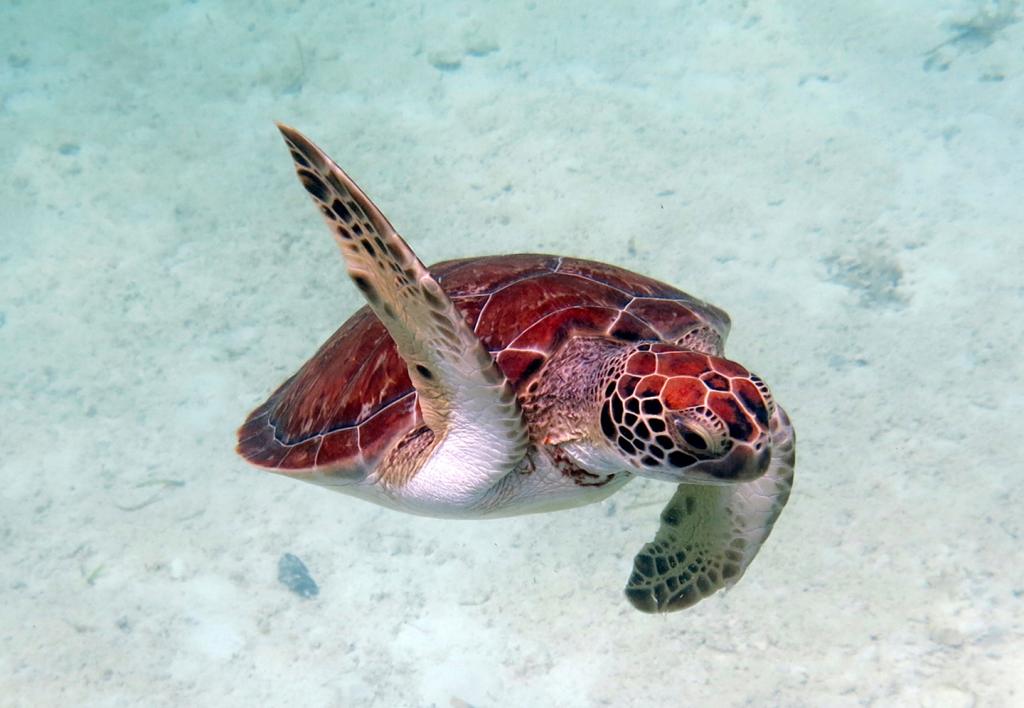
In 1973, governments also adopted the Convention on International Trade in Endangered Species of Wild Fauna and Flora (CITES). During the following decades, CITES focused on international trade of wild animals and plants, with an increasing focus on marine species. In 1979, the signing of the Convention on the Conservation of Migratory Species of Wild Animals led to additional efforts for the conservation and sustainable use of migratory animals and their habitats, including marine species.
“A Constitution for the Ocean” – The UN Convention on the Law of the Sea (UNCLOS)
“On 10 December 1982, we created a new record in legal history,” exclaimed Tommy Koh, the Singaporean President of the Third UN Conference on the Law of the Sea in his speech titled “A Constitution for the Ocean.” The UN Convention on the Law of the Sea (UNCLOS) had just opened for signature and 119 countries signed it on the first day. It took 36 years of negotiations and a “long and arduous journey to secure a new Convention that covers every aspect of the uses and resources of the sea.” UNCLOS, which comprises 18 Parts and deals with a multitude of topics, was “the result of an unprecedented effort at codification and progressive development of international law” (Treves, 2008).
The Convention divides marine areas into five main zones: internal waters, territorial sea, contiguous zones, exclusive economic zones (EEZ), and the high seas. UNCLOS defines the extent and legal status of these zones, establishing rights and jurisdictions. National jurisdiction generally decreases as the distance from the coast increases, ranging from full sovereignty to limited jurisdiction. The EEZ, a nautical zone of up to 370 kilometres (200 miles) from the coast, provides a sovereign coastal state special rights regarding the exploration and use of marine resources. Other provisions (UNCLOS Part XI) elaborate on the continental shelf, a portion of a continent submerged under an area of relatively shallow water. UNCLOS provisions on marine zones and the continental shelf did not solve territorial disputes, however. The Convention’s dispute settlement system includes the International Tribunal of the Law of the Sea, which decides on disputes concerning delimitation of maritime boundaries. The establishment of the Commission on the Limits of the Continental Shelf, under UNCLOS in 1997, aims to prevent or minimize disputes over overlapping EEZs, the limits of the continental shelf, or overlapping claims over outer continental shelf boundaries.
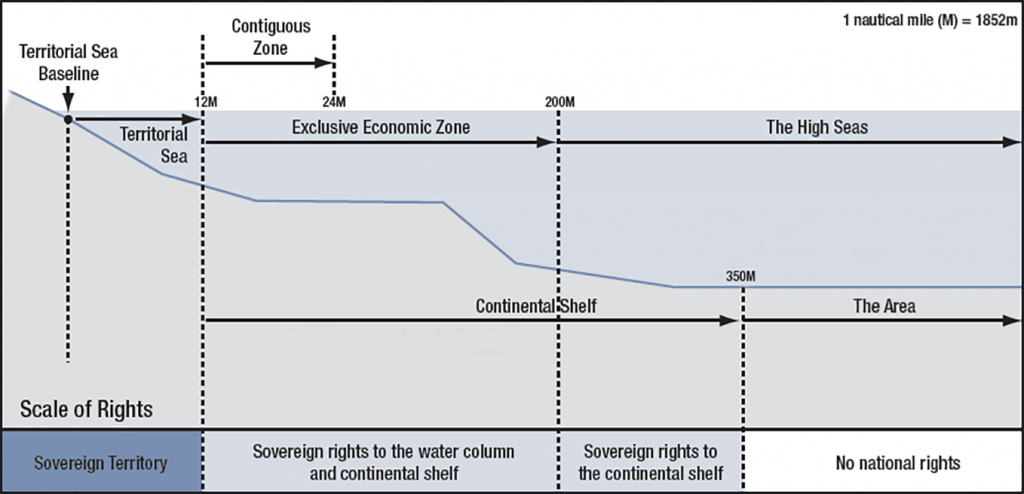
UNCLOS Part XI regulates mineral resources on the seabed, outside any state’s EEZ. It establishes the International Seabed Authority (ISA) to “organize, regulate, and control all mineral-related activities in the international seabed area for the benefit of humankind as a whole.” Negotiations on Part XI have been arduous, resulting in the 1994 Implementing Agreement. The ISA, fully operational since 1996, has issued 30 contracts for exploration activities for mineral resources. Since 2014, the Authority has undertaken work to develop exploitation regulations.
UNCLOS Part XII deals with the protection and preservation of the marine environment. Specific provisions of Part XII focus on marine pollution and establishes the duty to cooperate on a regional and global basis. The development of a general framework (UNCLOS Part XII) on marine pollution after the establishment of other relevant treaties (MARPOL, Paris Convention) portrays “the typical piecemeal approach to developing international law frequently followed after Stockholm” (Adede, 1995).
Second-wave Institutions – The 1992 Earth Summit
By the mid-1980s, the relationship between environment and development came to the fore with the publication of the report of the World Commission on Environment and Development, Our Common Future. This led to the 1992 UN Conference on Environment and Development (Earth Summit) in Rio de Janeiro, Brazil.
Agenda 21, one of the main outcome documents of the Earth Summit, provides an action plan for sustainable development. Chapter 17 tackles the protection of the ocean and its living resources. It calls for integrated management and “new approaches to marine and coastal area management and development that are integrated in content and are precautionary and anticipatory in ambit.”
The Rio Declaration on Environment and Development and the new set of treaties that stemmed from the Earth Summit incorporated novel concepts on sustainable development, including intergenerational considerations (Principles 3,4), the precautionary principle (Principle 15), the polluter pays principle (Principle 16), special consideration given to developing countries (Principle 6), and the principle of common but differentiated responsibilities (Principle 7), among others.
The 1992 Convention on Biological Diversity (CBD) launched its work programme on marine and coastal biodiversity to tackle “rapidly increasing and locally acute human pressure.” It includes work on defining and establishing ecologically or biologically significant areas (EBSAs), areas of the ocean that have special importance, for example as essential habitats or breeding grounds (Gannon et al., 2019).
Other processes and bodies, including numerous environmental non-governmental organizations, have also played a major part in conservation efforts, including the effort to establish a network of marine protected areas. Of particular note is the contribution of the International Union for Conservation of Nature in the evolution of ocean management (Robinson, 2005).
Fisheries Management
Following the establishment of nautical zones, including EEZs, UNCLOS effectively placed 64% of the ocean outside the jurisdiction of any state. Fishing in the high seas was not a priority problem during the UNCLOS negotiations. But as more countries claimed their EEZs, some traditional coastal fishing grounds were displaced and fishing activities in the high seas grew at an unsustainable rate. During the Earth Summit, delegates agreed to convene a UN conference on straddling and highly migratory fish stocks (fish that migrate through, or occur in, more than one EEZ). Three years later, that conference led to the 1995 Fish Stocks Agreement (FSA), which aims to ensure the long-term conservation and sustainable use of straddling and highly migratory fish stocks within the UNCLOS framework.
Inadequate management and overfishing in the high seas were already well documented by 1992 by the Food and Agriculture Organization of the UN (FAO). At the time the FSA agreement was signed, FAO adopted its Code of Conduct for Responsible Fisheries, a landmark document aiming to set international standards for sustainable practices regarding living aquatic resources.
The FAO has also established numerous regional fishery bodies (RFBs) as forums for regional cooperation for the conservation and sustainable use of fisheries. RFBs with a management mandate are called Regional Fisheries Management Organizations (RFMOs). Following UNCLOS guidance to “cooperate to establish subregional or regional fisheries organizations” for the conservation and management of living resources in the high sea (UNCLOS Article 118), states created a plethora of such structures. Numerous RFMOs cover geographical areas (e.g. the South Pacific Regional Fisheries Management Organization, the Western and Central Pacific Fisheries Commission, or the Northwest Atlantic Fisheries Organization). Other RFMOs regulate fishing for a particular species: there are five RFMOs on tuna, including the Indian Ocean Tuna Commission and the Commission for the Conservation of Southern Bluefin Tuna.
Regional bodies offer many advantages, including specific knowledge about the fish stocks in question. This decreases the high levels of uncertainty related to incomplete knowledge of and limited ability to observe the biological resources. However, the sheer number of fisheries management organizations and bodies, with often interrelated and overlapping jurisdictions and mandates, creates a highly complex policy environment. On the one hand, there is little evidence of significant cooperation between adjacent or overlapping organizations in the development and application of conservation measures; on the other, not all RFMOs share the same capacities to meet their objectives (Bell et al., 2019).
The 2030 Agenda for Sustainable Development and the Future of the Ocean Agenda
In 2015, governments adopted the 2030 Agenda for Sustainable Development, including its 17 Sustainable Development Goals (SDGs). SDG 14 (life below water) is devoted to the ocean. Its targets address marine pollution, ocean acidification, sustainable management of marine and coastal ecosystems, marine protected areas, overfishing, perverse subsidies, and small island development, providing a holistic framework on ocean governance.
Yet, despite the earnest efforts of the international community over the past 50 years, problems persist. Overfishing, resource extraction, tourism, recreation, coastal development, and pollution are damaging habitats and reducing populations of marine species at a frightening rate. Despite the establishment of numerous regional and global instruments to manage fisheries, the state of the world’s ocean and marine resources is much worse. The percentage of stocks fished at biologically unsustainable levels increased from 10% in 1974 to 34.2% in 2017 (FAO, 2020). Despite the multitude of governing instruments, the FAO admits these are “not always effectively implemented” (FAO, 2020).
New challenges, including climate change and sea-level rise, plastics and microplastics, anthropogenic underwater noise, ocean warming, and ocean acidification, are more prominent. Plastics and microplastics in the marine environment have increased dramatically and are a serious threat with complex ecotoxicological effects (Avio et al., 2017). Carbon pollution is changing the ocean’s chemistry making it more acidic. Ocean warming and acidification, although different phenomena, interact to the detriment of marine ecosystems, affecting primary productivity, nutrient cycles, and ultimately the survival of marine species. Anthropogenic underwater noise production has serious detrimental effects on ocean biodiversity (Williams et al., 2015).
Multiple stressors and the need to consider cumulative impacts require developing a more holistic approach to ocean governance, carefully based on integrated management and the ecosystem approach. Cumulative impacts cannot be managed in isolation and sectoral management efforts, while valuable for informing decisions, may prove inadequate to address future challenges. The 2030 Agenda provides a robust reference framework, but proper coordination is still lacking.
SDG 14: Conserve and sustainably use the oceans, seas and marine resources
14.1 By 2025, prevent and significantly reduce marine pollution of all kinds, in particular from land-based activities, including marine debris and nutrient pollution
14.2 By 2020, sustainably manage and protect marine and coastal ecosystems to avoid significant adverse impacts, including by strengthening their resilience, and take action for their restoration in order to achieve healthy and productive oceans
14.3 Minimize and address the impacts of ocean acidification, including through enhanced scientific cooperation at all levels
14.4 By 2020, effectively regulate harvesting and end overfishing, illegal, unreported and unregulated fishing and destructive fishing practices and implement science-based management plans, in order to restore fish stocks in the shortest time feasible, at least to levels that can produce maximum sustainable yield as determined by their biological characteristics
14.5 By 2020, conserve at least 10 per cent of coastal and marine areas, consistent with national and international law and based on the best available scientific information
14.6 By 2020, prohibit certain forms of fisheries subsidies which contribute to overcapacity and overfishing, eliminate subsidies that contribute to illegal, unreported and unregulated fishing and refrain from introducing new such subsidies, recognizing that appropriate and effective special and differential treatment for developing and least developed countries should be an integral part of the World Trade Organization fisheries subsidies negotiation
14.7 By 2030, increase the economic benefits to small island developing States and least developed countries from the sustainable use of marine resources, including through sustainable management of fisheries, aquaculture and tourism
14.A Increase scientific knowledge, develop research capacity and transfer marine technology, taking into account the Intergovernmental Oceanographic Commission Criteria and Guidelines on the Transfer of Marine Technology, in order to improve ocean health and to enhance the contribution of marine biodiversity to the development of developing countries, in particular small island developing States and least developed countries
14.B Provide access for small-scale artisanal fishers to marine resources and markets
14.C Enhance the conservation and sustainable use of oceans and their resources by implementing international law as reflected in UNCLOS, which provides the legal framework for the conservation and sustainable use of oceans and their resources, as recalled in paragraph 158 of “The Future We Want”
The Ocean in Deep Trouble
The ocean has gained traction in the UN system. In 1999, the UN General Assembly decided to establish the UN Open-ended Informal Consultative Process on Oceans and the Law of the Sea. In 2003, it created a coordinating body, UN-Oceans, which has met annually since 2005. In 2017, UN Secretary-General António Guterres appointed Peter Thomson of Fiji as his Special Envoy for the Ocean. The UN has proclaimed 2021-2030 a Decade for Ocean Science, aiming to reverse the cycle of decline in ocean health. The UN Ocean Conference was organized to mobilize action and support SDG 14.
But now the Ocean is in trouble and needs our help. 85% of global fish stocks are over-exploited… warming seas are causing widespread destruction of coral reefs… every year $23 billion worth of fish is being illegally caught every year, while 100 million sharks are killed just for their fins… rates of acidification and deoxygenation continue to rise… we pollute our coasts and our Ocean blue with unconscionable levels of pollution.
From a policy perspective, the most interesting development is the convening of an intergovernmental conference under UNCLOS to create an international legally binding instrument for the conservation and sustainable use of marine biodiversity in areas beyond national jurisdiction. While the negotiation process has been lengthy and challenging, a future treaty for the high seas may help cover existing policy gaps and play a coordinating role in ocean governance. Although the process was at the final stage of its scheduled work prior to the COVID-19-related disruption, many questions remain. What will be the relationship of the future instrument with other existing bodies, given the mandate notes it “should not undermine them”? Will fishing activities be included in the agreement? Will the new agreement be based on the common heritage of humankind principle and, if so, what would a future benefit-sharing regime look like? The answers to these questions will be decisive for future ocean governance.
While there are many uncertainties both in the scientific and policy realms, reality in the ocean is much more certain and paints a bleak picture that calls for urgent action. The evolution in ocean governance from Stockholm to SDG 14 has not altered the stakes, which remain as high as they can be: ocean health is intimately tied to our survival.
Works Consulted
Adede, A. O. (1995). The treaty system from Stockholm (1972) to Rio de Janeiro (1992). Pace Environmental Law Review, 13(1).
Avio, C.G., Gorbi, S., & Regoli, F. (2017). Plastics and microplastics in the oceans: From emerging pollutants to emerged threat. Marine Environmental Research, 128, 2-11.
Bell, J.B., Guijarro-Garcia, E., & Kenny, A. (2019). Demersal fishing in areas beyond national jurisdiction: A comparative analysis of RFMOs. Frontiers in Marine Science, 6.
Food and Agriculture Organization. (2020). The state of world fisheries and aquaculture 2020: Sustainability in action. http://www.fao.org/documents/card/en/c/ca9229en
Gannon, P., Dubois, G., Dudley, N., Ervin, J., Ferrier, S., Gidda, S., MacKinnon, K., Richardson, K., Schmidt, M., Seyoum-Edjigu, E., & Shestakov, A. (2019). Editorial Essay: An update on progress towards Aichi Biodiversity Target 11. Parks, 25.2, 7–18. https://doi.org/10.2305/iucn.ch.2019.parks-25-2pg.en
Peterson, M.J. (1992). Whalers, cetologists, environmentalists, and the international management of whaling. International Organization, 46(1), 147–186.
Robinson, N. (2005). IUCN as catalyst for a law of the biosphere: Acting globally and locally. Environmental Law, 35(249). http://digitalcommons.pace.edu/lawfaculty/368/
Treves T. (2008). United Nations Convention on the Law of the Sea. UN Audiovisual Library of International Law. https://legal.un.org/avl/pdf/ha/uncls/uncls_e.pdf
Williams, R., Wright, A., Ashe, E., Blight, L., Bruintjes, R., Canessa, R., Clark, C., Cullis-Suzuki, S., Dakin, D., Erbe, C., Hammond, P., Merchant, N., O’Hara, P., Purser, J., Radford, A., Simpson, S., Thomas, L., & Wale, M. (2015). Impacts of anthropogenic noise on marine life: Publication patterns, new discoveries, and future directions in research and management. Ocean & Coastal Management, 115, 17–24. https://doi.org/10.1016/j.ocecoaman.2015.05.021
Additional downloads
You might also be interested in
A Warming Arctic is a Warning for the World
To protect the Arctic, stronger and broader local, national, and international measures to reduce greenhouse gas emissions must be implemented.
IISD Annual Report 2023–2024
While IISD's reputation as a convenor, a trusted thought leader, and a go-to source on key issues within the sustainable development field is stronger than ever, the work happening outside the spotlight is just as valuable.
Indigenous Peoples: Defending an Environment for All
International environmental negotiations need to go beyond tokenistic participation of Indigenous Peoples to a genuine integration of their worldviews and knowledge.
The Water and Sanitation Challenge
For universal access to water to become a reality, governments and private-sector service providers should adopt a human rights-based approach to ensure water and sanitation services are safe, available, accessible, affordable, and culturally acceptable.
